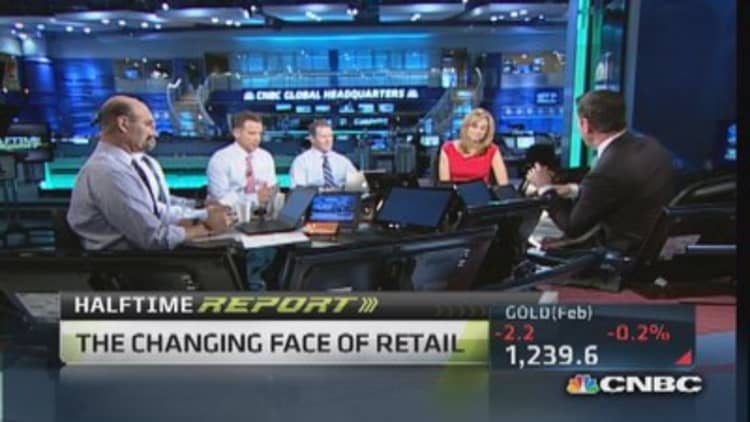
Consider this scenario: You want that hot new gaming device so badly that you schedule a reminder alarm so that you can add it to your cart as soon as it goes on sale.
You don't like to pay for shipping, though, so you choose to buy it online and swing by the store to pick it up on the way home from work. Easy. But when you get to the store, the manager greets you with four unwelcome words: We're out of stock.
But what if that isn't really the case?
According to industry experts, one of the biggest issues in the integration of online shopping and physical stores isn't technology but identifying where to assign sales credit or commission for a purchase that is made online and fulfilled in-store.
(Read more: It's Black Friday again! Retail woes are as deep as the discounts)
The problem has been known to encourage bad behavior in store managers and sales associates, who sometimes stash popular items to sell in the store—and to ensure they get credit for the sale.
"The single greatest obstacle to what the shopper wants, in my opinion, is not technology [or] merchandise, but the issue of revenue recognition," said Jon Stine, retail industry director at Cisco Consulting Services.
Retailers are reluctant to discuss the problem because it's complicated and takes a number of approaches, according to Vincent Quan, an associate professor at the Fashion Institute of Technology who has experience at Saks Fifth Avenue.
Some companies split the sales credit 50-50 between the Web operation and the store, while others attribute the sale to the store that supplies the inventory, Quan said.
Another option is to credit the sale to the Web, assuming that the associate's work is limited to pulling the already-selected inventory from a stockroom. While that method may seem logical, removing inventory from the store and attributing the sale to the Web creates an accounting imbalance.
"The sale is one piece—the inventory's another," Quan said.
Not a new problem
Although the assigning of sales credit was a hot-button topic among exhibitors at the recent National Retail Federation convention, it dates back about 10 years, to when the now-defunct Circuit City allowed in-store pickup for online orders, said Forrester Research analyst Sucharita Mulpuru.
Its importance has grown with the popularity of e-commerce, especially as traditional stores work to create a fluid shopping experience that spans both the virtual and physical.
Best Buy, J.C. Penney and Walmart are among companies allowing shoppers to buy an item online and collect it in a store, while Gap allows customers to reserve up to five items to be held at a store until closing the following day.
Shipping items to a store is both convenient for the shopper and beneficial to the store, Mulpuru said. More consumers have come to expect free shipping of online orders, so it's often cheaper to ship to commercial stores than to send products to residential addresses.
(Read more: 5 major problems retailers must fix in 2014)
"I think that in-store pickup is going to be an imperative in years to come," she said. "It can be a silver bullet for e-commerce. … Just don't do it badly."
Enforcing good practices
Though few mass retailers pay commission, Dan Butler, vice president of operations at the NRF, said that high-end luxury retailers and big-ticket categories in department stores, including fine jewelry and furniture, typically follow a commission structure.
Shoe and cosmetics departments also tend to run on commission. The percentage paid to store associates varies, as does whether they also receive a base salary.
J.C. Penney recently announced that it will bring back its commission-based pay structure for several departments, including fine jewelry.
(Read more: A 'tsunami' of store closings expected to hit retail)
Regardless of whether a store offers commission, identifying the proper sales channel is important in determining where to assign credit, and many firms are hiring executives who specialize in Web and in-store integration to ensure that, according to Mulpuru at Forrester.

Charlie DeWitt, vice president of business development at workforce management firm Kronos, said that any approach needs to have a level of transparency and accountability, and that these work both ways. Store managers and corporate executives need to see the effects of disappointing online shoppers, including the loss of repeat business and brand loyalty.
"In the early days the guys that set up the e-channel wanted credit for everything, but they're missing the boat with the store managers," DeWitt said. "Then you get bad customer service … and the sales don't grow."
Quan at FIT echoed that, saying consumers don't care where the inventory comes from—they just want to know the price and when they're going to get it.
"The last thing a retailer wants to do is upset a consumer and have it go viral," he said.
(Read more: Online stores think local to act global)
Although experts differ on the answer (Mulpuru is a proponent of assigning credit to the store, while Quan said it should go to the Web), being realistic is the key to keeping everyone happy, Mulpuru said.
Instead of just reserving the items in-store, retailers should collect payment in all transactions to reduce the number of items that are never picked up, she said. If an item isn't picked up within a certain time, it should go back on the shelf. Also, there should also be a limit on how many items can be bought online and picked up in-store.
"Of course you're going to generate channel conflict when you make bad decisions," Mulpuru said. "In-store pickup is not trivial. It's a hard practice to get right … but it's going to be table stakes in years to come."
—By CNBC's Krystina Gustafson. Follow her on Twitter @KrystinaGustafs.


